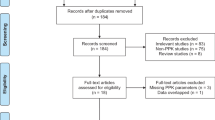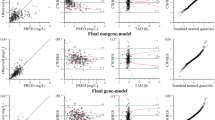Abstract
Objective
To assess the population pharmacokinetics of levetiracetam, a second-generation antiepileptic drug, in adult Japanese and Western populations.
Methods
Data were pooled from ten matched clinical trials conducted in Japan and in Europe and the USA, in which levetiracetam was administered orally to healthy subjects and subjects with epilepsy. Overall, 5408 plasma concentrations were available from 524 subjects in six clinical pharmacology studies and two confirmatory and two long-term safety studies of add-on treatment for partial epilepsy. A one-compartment open model with first-order absorption and elimination was fitted to the plasma concentrations using nonlinear mixed-effects modelling with first-order estimation.
Results
Ethnicity had no statistically significant effect on the pharmacokinetics of levetiracetam in the presence of the other covariates. Bodyweight, sex, creatinine clearance and concomitant intake of enzyme inducers or valproic acid had a statistically significant effect on apparent plasma clearance of levetiracetam. Bodyweight, disease and valproic acid had a statistically significant effect on the volume of distribution. Levetiracetam exposure (the area under the plasma concentration-time curve over the 12-hour dosing interval at steady state) was 12% higher in females than in males. Decreasing bodyweight from 70kg to 40kg was predicted to increase exposure by 16%, while halving creatinine clearance was predicted to increase exposure by 10%. Enzyme inducers reduced exposure by 8%, while valproic acid resulted in a 23% increase in exposure. The latter effect was assumed to arise from the known association between valproic acid and increased body fat, since levetiracetam is negligibly metabolised by cytochrome P450 enzymes.
Conclusions
Population pharmacokinetic analysis points to the absence of ethnic differences in the pharmacokinetics of levetiracetam between Japanese and Western populations, other than those arising from bodyweight differences. Small, clinically non-relevant differences between individual demographic characteristics suggest that dose adjustment is usually not necessary.








Similar content being viewed by others
References
Margineanu DG, Klitgaard H. Levetiracetam mechanism of action in antiepileptic drugs. In: Levy RH, Mattson RH, Meldrum BS, et al., editors. Antiepileptic drugs. 5th ed. Philadelphia (PA): Lippincott Williams & Wilkins, 2002: 419–27
Lynch BA, Lambeng N, Nocka K, et al. The synaptic vesicle protein SV2A is the binding site for the antiepileptic drug levetiracetam. Proc Natl Acad Sci USA 2004; 101: 9861–6
Cereghino JJ, Biton V, Abou-Khalil B, et al. Levetiracetam for partial seizures: results of a double-blind, randomized clinical trial. Neurology 2000; 55: 236–42
Shorvon SD, Löwenthal A, Janz D, et al. Multicenter doubleblind, randomized, placebo-controlled trial of levetiracetam as add-on therapy in patients with refractory partial seizures. Epilepsia 2000; 41: 1179–86
Boon P, Chauvel P, Pohlmann-Eden B, et al. Dose-response effect of levetiracetam 1000 and 2000 mg/day in partial epilepsy. Epilepsy Res 2002; 48: 77–89
Ben-Menachem E, Edrich P, Van Vleymen B, et al. Evidence for sustained efficacy of levetiracetam as add-on epilepsy therapy. Epilepsy Res 2003; 53: 56–64
Glauser TA, Ayala R, Elterman RD, et al. A double-blind randomized placebo-controlled trial of levetiracetam adjunctive therapy in children with partial seizures. Neurology 2006; 66: 1654–60
Patsalos PN. Pharmacokinetics profile of levetiracetam: toward ideal characteristics. Pharmacol Ther 2000; 85: 77–85
Radtke RA. Pharmacokinetics of levetiracetam. Epilepsia 2001; 42 Suppl. 4: 24–7
Strolin Benedetti M, Whomsley R, Nicolas JM, et al. Pharmacokinetics and metabolism of 14C-levetiracetam, a new antiepileptic agent, in healthy volunteers. Eur J Clin Pharmacol 2003; 59: 621–30
Gidal B, Baltes E, Otoul C, et al. Effect of levetiracetam on the pharmacokinetics of adjunctive antiepileptic drugs: a pooled analysis of data from randomized clinical trials. Epilepsy Res 2005; 64: 1–11
Perucca E, Gidal BE, Baltes E. Effects of antiepileptic comedication on levetiracetam pharmacokinetics: a pooled analysis of data from randomized adjunctive therapy trials. Epilepsy Res 2003; 53: 47–56
Johannessen SI, Battino D, Berry DJ, et al. Therapeutic drug monitoring of the newer antiepileptic drugs. Ther Drug Monit 2003; 25: 347–63
Bjornsson TD, Wagner JA, Donahue SR, et al. A review and assessment of potential sources of ethnic differences in drug responsiveness. J Clin Pharmacol 2003; 43: 943–67
Cockroft DW, Gault MH. Prediction of creatinine clearance from serum creatinine. Nephron 1976; 16: 31–41
Murasaki M. UCB L059 phase-I clinical trial: single administration study. Tokyo: UCB Japan Ltd, 1998. (Data on file)
Murasaki M. UCB L059 phase-I clinical trial: repeated administration study. Tokyo: UCB Japan Ltd, 1998. (Data on file)
Murasaki M. UCB L059 phase-I clinical trial: food interaction study. Tokyo: UCB Japan Ltd, 1998. (Data on file)
Murasaki M. Double blind bridging efficacy study of UCB L059 (levetiracetam) in patients with epilepsy. Tokyo: UCB Japan Ltd, 2005. (Data on file)
Murasaki M. Open label follow up study of UCB L059 (leve-tiracetam) in epileptic patients with partial onset seizures. Tokyo: UCB Japan Ltd, 2005. (Data on file)
Abou-Khalil B, Schaich L. Long term efficacy of levetiracetam for partial seizures. Seizure 2005; 14: 577–85
Coupez R, Nicolas JM, Browne TR. Levetiracetam, a new antiepileptic agent: lack of in vitro and in vivo pharmacokinetic interaction with valproic acid. Epilepsia 2003; 44: 171–8
Beal SL, Sheiner LB. NONMEM Project Group. NONMEM user’s guide. San Francisco (CA): University of California, 1992
El Desoky E, Fuseau E, El Din Amry S, et al. Pharmacokinetic modeling of valproic acid from routine clinical data in Egyptian epileptic patients. Eur J Clin Pharmacol 2004; 59: 783–90
Mahmood I. Interspecies scaling: predicting volumes, mean residence time and elimination half-life. Some suggestions. J Pharm Pharmacol 1998; 50: 493–9
West GB, Brown JH, Enquist BJ. A general model for the origin of allometric scaling laws in biology. Science 1997; 276: 122–6
May TW, Rambeck B, Jurgens U. Serum concentrations of levetiracetam in epileptic patients: the influence of dose and co-medication. Ther Drug Monit 2003; 25: 690–9
Contin M, Albani F, Riva R, et al. Levetiracetam therapeutic monitoring in patients with epilepsy: effect of concomitant antiepileptic drugs. Ther Drug Monit 2004; 26: 375–9
Ramael S, De Smedt F, Toublanc N, et al. Single-dose bioavailability of levetiracetam intravenous infusion relative to oral tablets and multiple-dose pharmacokinetics and tolerability of levetiracetam intravenous infusion compared with placebo in healthy subjects. Clin Ther 2006; 28: 734–44
Genton P, Gelisse P. Valproic acid: adverse effects. In: Levy RH, Mattson RH, Meldrum BS, et al., editors. Antiepileptic drugs. 5th ed. Philadelphia (PA): Lippincott Williams and Wilkins, 2002: 837–51
Betts T, Waegemans T, Crawford P. A multicentre, doubleblind, randomized, parallel-group study to evaluate the tolerability and efficacy of two oral doses of levetiracetam, 2000mg daily and 4000mg daily, without titration in patients with refractory epilepsy. Seizure 2000; 9: 80–7
Acknowledgements
The study was sponsored by UCB SA as part of the clinical development programme for levetiracetam in Japan. Etienne Pigeolet, Maria-Laura Sargentini-Maier and Armel Stockis are employees of UCB Pharma SA, Braine-l’Alleud, Belgium. Philippe Jacqmin has no conflicts of interest to declare in connection with this work.
Author information
Authors and Affiliations
Corresponding author
Rights and permissions
About this article
Cite this article
Pigeolet, E., Jacqmin, P., Sargentini-Maier, ML. et al. Population Pharmacokinetics of Levetiracetam in Japanese and Western Adults. Clin Pharmacokinet 46, 503–512 (2007). https://doi.org/10.2165/00003088-200746060-00004
Published:
Issue Date:
DOI: https://doi.org/10.2165/00003088-200746060-00004




